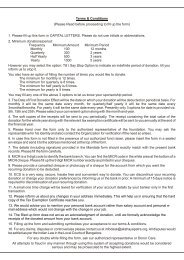The Top 100 NGOs 2013. - Akshaya Patra
The Top 100 NGOs 2013. - Akshaya Patra
The Top 100 NGOs 2013. - Akshaya Patra
Create successful ePaper yourself
Turn your PDF publications into a flip-book with our unique Google optimized e-Paper software.
<strong>The</strong> gloBal review + Books <strong>The</strong> gloBal review + Books<br />
MANNING THE GATES THE ROAd TO RUIN IRANIANS ON THE COUCH POST-RACIAL MYTH-BUSTING? WHEN POLITICS ANd dISASTER COLLIdE<br />
fortreSS eUrope:<br />
diSpatcheS froM a Gated<br />
continent<br />
maT<strong>The</strong>w carr<br />
hursT & co<br />
£20.00<br />
“On 28 May 1999, a Sudanese asylum<br />
seeker named Aamir Ageed died during<br />
a deportation flight from Frankfurt to<br />
Cairo, after police forced his helmeted<br />
head between his knees to restrain<br />
him.” “In March 2005, a Russian<br />
couple and their son jumped to their<br />
deaths from a Glasgow housing estate<br />
because they faced deportation.”<br />
<strong>The</strong>se two examples, outlined in<br />
Matthew Carr’s straightforward prose,<br />
demonstrate the contradictory nature<br />
of the 1995 Schengen Agreement – an<br />
agreement that has opened the gates<br />
for millions of Europeans, whilst<br />
simultaneously slamming them in the<br />
face of the rest of the world. Indeed,<br />
Carr’s exposé is littered with accounts<br />
of eternal detention centers, rogue<br />
coastguards, humiliating beatings<br />
and, finally, “positional asphyxia.”<br />
His personal interviews with migrants<br />
themselves provide a voice to a people<br />
that have previously been ignored in the<br />
European discourse on immigration and<br />
refugees. Besides filling the reader with<br />
a sense of hopelessness and despair,<br />
Carr’s work leads to the irresistible<br />
conclusion that the West must be held<br />
accountable for numerous human rights<br />
violations, as well as compelling us to<br />
question the logic of border restrictions<br />
in the first place.<br />
Nevertheless, the book, although<br />
extremely powerful, provides little room<br />
for alternative interpretation. In fact,<br />
two glaring gaps in the narrative lead<br />
one to doubt the complete validity of<br />
Carr’s account. First and foremost, he<br />
does not explore the European Union’s<br />
(EU) current approach to immigration,<br />
and the reader is left with an impression<br />
of a powerful and uncaring hegemony.<br />
His research on Greece, for instance,<br />
uncovers thousands of violations of the<br />
Geneva Conventions – including refusing<br />
to process asylum requests as well as<br />
abandonment of refugees at sea. What<br />
he does not mention, however, is that<br />
Greece is no longer considered part of<br />
the ‘Dublin System’ – meaning the EU<br />
allows refugees to process their claims<br />
in other Schengen states. Secondly,<br />
Carr does not explicitly link the current<br />
anti migrant attitude to contemporary<br />
economic realities. It is hard to imagine<br />
Greece or Spain reconsidering their<br />
border policies given the current rate<br />
of unemployment.<br />
Yet despite these omissions, Carr’s work<br />
provides invaluable information on the<br />
true goings-on within the European<br />
refugee system. His interviews with<br />
intergovernmental, international<br />
and national organizations provide a<br />
comprehensive account of the attitudes<br />
of officialdom – while his one-on-one<br />
conversations with migrants themselves<br />
give the story a much-needed<br />
human face.<br />
- CH<br />
<strong>The</strong> gloBal Journal + January & FeBruary 2013<br />
David W Lesch, a historian specializing<br />
in the Middle East, is among the<br />
handful of Westerners to have<br />
gained exclusive, private access to<br />
one of the world’s most elusive and<br />
despised leaders: Bashar al-Assad.<br />
An informative and personal account,<br />
Syria tracks the early rise of the young<br />
ophthalmologist – once nicknamed<br />
“<strong>The</strong> Hope” – before a deluded decline,<br />
culminating in one of the bloodiest<br />
repressions in recent history.<br />
An easy read, the book showcases<br />
the sympathy brought about by the<br />
author’s former proximity to Assad,<br />
though he remains clear and carefully<br />
nuanced when charting the internal<br />
transformation and foreign power-play<br />
that accompanied the decline of the<br />
regime. Lesch is particularly successful<br />
in his description of the violent turn<br />
that has commanded international<br />
attention over the last year and a half,<br />
documenting the behind-the-scenes<br />
activities of a man who did not so<br />
much change the system as be himself<br />
changed by it.<br />
Unsurprisingly, Lesch’s outlook for<br />
Syria is as dire as his disappointment:<br />
a failed state with extremist elements<br />
situated on Middle East fault lines.<br />
Ultimately, the book offers an insightful<br />
look into a nation caught in a tragically<br />
inevitable downwards spiral. “When a<br />
domestic threat appears, there is a pushbutton<br />
response of quick and ruthless<br />
repression,” Lesch writes. “<strong>The</strong> real<br />
story… would have been if Bashar had<br />
not pressed that button.”<br />
- CT<br />
Syria: the fall of the<br />
hoUSe of aSSad<br />
DaviD w lesch<br />
yale universiTy Press<br />
$28.00<br />
Doing Psychoanalysis in Tehran is<br />
not about human rights violations,<br />
democracy or freedom of speech.<br />
Gohar Homayounpour challenges<br />
Western preconceptions of a stigmatized<br />
society by weaving a graceful narrative<br />
between biographical segments and the<br />
stories of ordinary people. Although<br />
psychoanalysis was a European<br />
discovery, through the anxieties of her<br />
patients the author shows how pain is<br />
everywhere, with the science finding<br />
fertile ground even on ‘foreign’ shores.<br />
When Homayounpour lands in Tehran<br />
after a 20-year absence, she is startled<br />
initially by feelings of disillusionment,<br />
pain and ambivalence. To heal this<br />
malaise, the author looks to her master<br />
Kundera for inspiration in an attempt<br />
to shed light on the darkness of<br />
human souls. Her patients themselves<br />
become narrators, telling stories that<br />
serve to disguise unspoken realities.<br />
From the first session with Mrs N – a<br />
famous painter – we understand that<br />
psychoanalysis is a dynamic game<br />
between the analyst and patient, each<br />
coming face to face with a stranger that<br />
is not the Other, but within themselves.<br />
Ultimately, Doing Psychoanalysis<br />
in Tehran draws an illuminating<br />
cross-section of Iranian society that<br />
demonstrates to the reader the common<br />
humanity shared by a New Yorker and<br />
her Iranian patients, despite perceived<br />
political and cultural differences – the<br />
“radiographic picture of the human<br />
condition” so evocatively described<br />
by filmmaker Abbas Kiarostami in his<br />
introduction to the book.<br />
<strong>The</strong>gloBalJournal.neT<br />
126 127<br />
- NZ<br />
doinG pSychoanalySiS in<br />
tehran<br />
gohar homayounPour<br />
<strong>The</strong> miT Press<br />
$19.95<br />
Tackling the Obama-era idea of the<br />
post-racial society head on, sociologist<br />
Karen E Fields and historian Barbara<br />
J Fields argue in their new book,<br />
Racecraft, that race does not produce<br />
racism, but rather, the other way<br />
around. Indeed, they drive their<br />
point home more deeply by linking<br />
race – and its emphasis on physical<br />
difference – with witchcraft. <strong>The</strong>se two<br />
concepts have been repeatedly used as<br />
‘evidence’ for racial divides, despite, of<br />
course, their obvious fallacy. Race, like<br />
witchcraft, is a delusion.<br />
In other words, the American practice<br />
of race categorization enforces racial<br />
division within society. With examples<br />
ranging from the profound to the absurd<br />
– including, for instance, an imaginary<br />
interview with W E B Dubois and Emile<br />
Durkheim, as well as personal porch<br />
chats with the authors’ grandmother<br />
– the Fields delve into “racecraft’s”<br />
profound effect on American political,<br />
social and economic life.<br />
<strong>The</strong> authors’ account illustrates that<br />
race categorization does not simply<br />
affect a small subset of the population,<br />
but instead engenders inequality<br />
throughout society. <strong>The</strong>ir analysis<br />
of the antebellum South, for example,<br />
highlights the fact the plantation<br />
system not only enslaved Africans,<br />
but also enforced an unequal caste<br />
system amongst the white population.<br />
Such anecdotes prompt the reader to<br />
realize that America – to truly tackle<br />
the problem of racism – must<br />
contemplate an entirely new language<br />
to describe race.<br />
- CH<br />
racecraft: the SoUl of<br />
ineqUality in aMerican<br />
life<br />
karen e FielDs & BarBara<br />
J FielDs<br />
verso Books<br />
£20.00<br />
As international attention on<br />
natural disasters increases, John<br />
Hannigan examines the latest trend<br />
in international politics to resolve<br />
“borderless” issues. Conceived as a<br />
textbook reviewing contemporary<br />
debates, Disasters Without Borders<br />
presents a comprehensive account of<br />
the failures of diplomacy in the realm of<br />
disaster management. <strong>The</strong> book views<br />
the field through an intense politicosociological<br />
lens, from the emergence of<br />
Disaster Risk Reduction in the 1980s, to<br />
the recent integration of climate change<br />
debates into humanitarian<br />
relief strategies.<br />
Disasters Without Borders provides a<br />
critical look at the political discourse of<br />
disasters as a thinly veiled disguise for<br />
hegemonic agendas. Hannigan’s text<br />
culminates with a presentation of two<br />
competing theoretical approaches that<br />
explain the diffusion of norms and<br />
ideas by non-state actors beyond a<br />
Realist perspective. In a rather anticlimactic<br />
fashion, however, he finds<br />
that both fall short, but does not<br />
present an alternative, leaving readers<br />
empty-handed.<br />
<strong>The</strong> book concludes with the “SCPQ<br />
Configuration” (Securitization,<br />
Catastrophe Scenario Building<br />
and Modeling, Privatization, and<br />
Quantification) embodying the current<br />
state of disaster institutions. Overall,<br />
Disasters Without Borders is an enjoyable,<br />
easily accessible read, but lacks new<br />
insight into tackling the dismal failures<br />
of environmental cooperation.<br />
- KC<br />
diSaSterS WithoUt<br />
borderS<br />
John hannigan<br />
PoliTy Press<br />
£13.95





